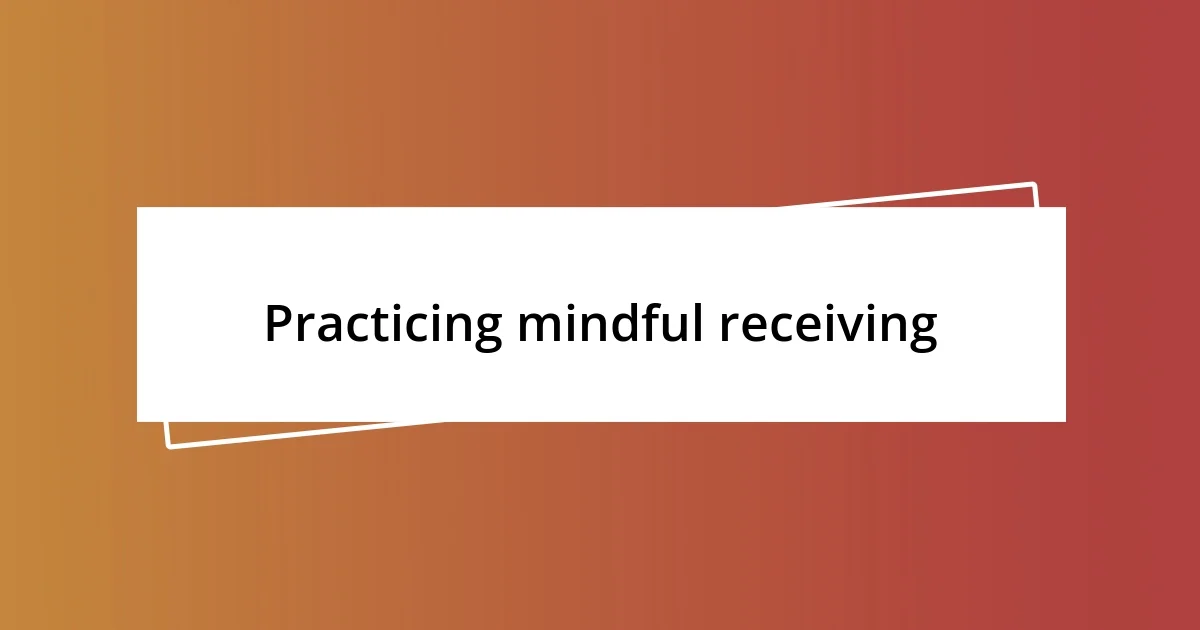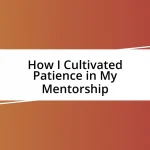Key takeaways:
- Finding balance in giving and receiving enriches relationships and fosters a sense of community, emphasizing mutual support.
- Recognizing personal limits and establishing boundaries is essential to sustain the ability to give and receive effectively.
- Practicing mindfulness in receiving enhances self-esteem and strengthens connections, highlighting the importance of gratitude in the balance of exchanges.

Understanding the concept of balance
Finding balance in giving and receiving can often feel like walking a tightrope. I remember a time when I was so focused on helping others that I neglected my own needs. It made me reflect—what’s the point of being generous if I’m running on empty?
Balance isn’t just a mathematical equation; it’s a dance between what we offer and what we accept. I once attended a workshop on emotional intelligence, and it struck me how vital it is to allow ourselves to receive as graciously as we give. It begs the question: how can we truly nurture our relationships if we’re unwilling to let others bless us in return?
When I think about balance, I envision a scale. On one side, I place my acts of kindness, while on the other, I weigh the support I graciously receive. If we tip too far either way, we risk losing sight of the joy that comes from mutual exchange. Have you ever felt that profound connection when you both give and receive freely? It’s in these moments that we find the true essence of balance.

Importance of giving and receiving
The importance of giving and receiving extends far beyond mere exchanges; it fosters deeper connections and mutual understanding. I recall a time when I helped a friend through a tough situation. While it felt fulfilling to support them, the gratitude and warmth they expressed in return illuminated how much I valued that reciprocity. It’s in these shared moments that relationships bloom—each act of giving nurtures a space for receiving, creating a cycle of kindness.
Additionally, embracing the practice of both giving and receiving cultivates a sense of community. I’ve participated in local charity events, where sharing my time and skills opened doors to friendships and collaboration. Each time I accepted help from others, be it their expertise or encouragement, I felt a profound sense of belonging. This balance creates a network of support where everyone contributes their strengths, benefiting the collective.
Finally, recognizing the significance of this balance can enrich our lives and cultivate resilience. I’ve learned that it’s okay to lean on others during challenging times. One day, when I was feeling overwhelmed, I accepted help from a colleague. Their support not only lightened my load but also strengthened our professional relationship. This exchange reminded me that every act of support furthers our ability to thrive individually and together, making us more resilient in the face of adversity.
| Aspect | Giving | Receiving |
|---|---|---|
| Emotional Impact | Often leads to feelings of fulfillment and purpose | Can create feelings of gratitude and connection |
| Social Dynamics | Builds trust and strengthens relationships | Promotes a sense of community and support |
| Personal Growth | Encourages empathy and selflessness | Enhances resilience and self-acceptance |

Recognizing your personal limits
Recognizing your personal limits is crucial in the delicate dance of giving and receiving. I remember a period when I took on more volunteer work than I could handle. I was driven by a desire to help, but I quickly found myself drained and less effective. This realization was a wake-up call; understanding my limits allowed me to engage fully when I did give.
To help establish and maintain personal boundaries, I’ve found reflection to be invaluable. Here are some key aspects to consider:
- Energy Levels: Assess how much emotional and physical energy you have left after giving.
- Time Commitments: Keep track of how many commitments you can realistically take on without feeling overwhelmed.
- Emotional Resilience: Recognize the point at which helping becomes a burden rather than a joy.
- Support System: Identify who you can lean on when you need assistance and make sure to nurture those relationships.
- Self-Care Practices: Incorporating routines that replenish your energy and spirit is essential for sustaining a giving nature.
Understanding these limits has transformed the way I give and receive. I’ve learned it’s okay to step back when needed, ensuring that both my acts of kindness and the graciousness of accepting help align harmoniously.

Strategies for effective giving
One strategy I find incredibly useful for effective giving is being intentional about my efforts. I remember volunteering at a local shelter during the holidays, and instead of just showing up, I took time to think about how I could make the experience meaningful for both the recipients and myself. This focus helped me create special moments—like sharing stories with families—which left a lasting impact on all of us. When we give with purpose, it transforms our interactions into genuine connections that resonate deeply.
Another approach I often utilize is to offer help in ways that align with my strengths and passions. For instance, I once organized a workshop to teach basic financial literacy in my community. It felt rewarding, not just because I was helping others, but because I was sharing something I genuinely love. Have you ever felt that spark when your skills meet someone else’s need? It’s a beautiful balance that not only makes the giving worthwhile but also enhances my own growth in the process.
Lastly, I find it vital to acknowledge the small, everyday acts of giving that often go unnoticed. For example, I make it a point to compliment a colleague or check in on a friend just to see how they’re doing. It may seem minor, but these tiny gestures accumulate and foster an atmosphere of connection. Isn’t it fascinating how even the smallest acts of kindness can ripple out to create a larger impact? When we make an effort to give in these simple ways, we’re not just enriching others’ lives; we’re nurturing our own as well.

Practicing mindful receiving
Mindful receiving has truly changed my perspective on how I connect with others. I recall a time when a friend insisted on treating me to dinner after a particularly challenging week for both of us. Initially, I hesitated, feeling like I was imposing. But I paused, feeling the warmth of their generosity wash over me. Accepting their offer allowed me to experience the joy of connection and gratitude. Have you ever found yourself in a similar position, hesitant to receive? It’s in these moments that we can rediscover the beauty of accepting kindness.
Practicing mindfulness in receiving means being present and acknowledging the emotions that come with it. When someone offers help, I’ve learned to take a breath and truly absorb what is being offered, whether it’s support, encouragement, or a simple compliment. One particular moment stands out for me: I received unexpected praise during a team meeting. Instead of brushing it off or downplaying it, I allowed myself to feel proud and appreciated. It was a small yet profound step in fostering a more open and positive mindset. Why do we so often shy away from celebrating our achievements? Embracing these moments helps build our self-esteem and strengthens our connections with others.
To deepen my practice of mindful receiving, I’ve taken to journaling about these experiences. After significant interactions, I note how it felt to receive something—be it a gesture, words of encouragement, or physical help. This practice helps me appreciate the richness of human connection and reminds me that allowing others to give is a gift in itself. Have you ever considered reflecting on your receiving moments? I’ve discovered that this reflection not only enhances my ability to accept but also reminds me of the impact that receiving has on my relationships, making them more vibrant and fulfilling.

Creating a healthy balance
Creating a healthy balance between giving and receiving is like learning a dance; it takes practice and awareness. I remember a time when I volunteered at a community garden. While I was thrilled to offer my time and energy, I realized that I was equally blessed by the friendships I developed there. It made me wonder—how often do we overlook the joy we gain from the very acts we think are solely about giving?
To maintain this balance, I’ve found it crucial to check in with myself regularly. There was a period in my life when I was pouring myself into helping others without acknowledging my own needs. I got burned out, feeling drained and undervalued. When I finally began setting boundaries, it was enlightening. Have you ever felt like giving came at the expense of your own well-being? Listening to my inner voice has been vital for creating a more sustainable approach to both giving and receiving.
Another strategy that really resonates with me is to cultivate an attitude of gratitude. Whenever I engage in acts of giving, I also make it a point to reflect on what I receive in return—be it personal growth, connections, or simply the joy of helping. Recently, I started a gratitude journal where I jot down these reflections. It keeps me grounded and reminds me that the act of giving often circles back, enriching both parties. Isn’t it fascinating how gratitude can transform our perspective? By fostering this awareness, I can better appreciate how giving and receiving weave together to create a fulfilling life.

Assessing your progress and adjustments
Assessing my progress in balancing giving and receiving has been an enlightening journey. I remember a period when I dedicated countless hours to community service without pausing to reflect on how it affected me emotionally. Over time, I realized that while my intentions were noble, neglecting my own needs led to feelings of resentment. How often do we get caught in this cycle without recognizing its impact? Taking a step back and evaluating my emotional state allowed me to realign my efforts.
Adjustments are essential for maintaining a healthy equilibrium. For instance, I started incorporating self-care days into my routine to recharge. Initially, it felt indulgent and even selfish, but I quickly learned that when I nurture myself, I can give more authentically to others. What does self-care look like for you? It could be as simple as setting aside time to read, walk, or even indulge in a favorite hobby. These adjustments have proven vital in supporting my ongoing commitment to balance.
I often find that tracking my emotional reactions helps illuminate patterns. Periodically, I list down moments of giving and receiving, alongside my feelings during those times. One time, after donating to a local charity, I felt a rush of happiness that lingered long after—a reminder that the exchange is reciprocal. Have you ever reflected on how such moments make you feel? This practice not only highlights my progress but also guides my future interactions, ensuring they are balanced and fulfilling.














